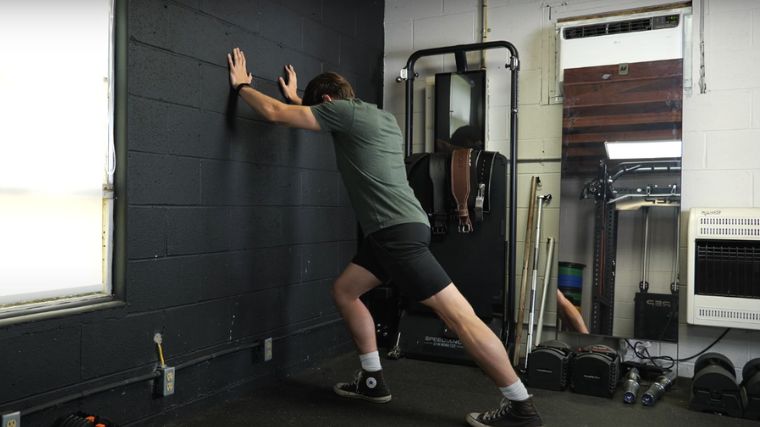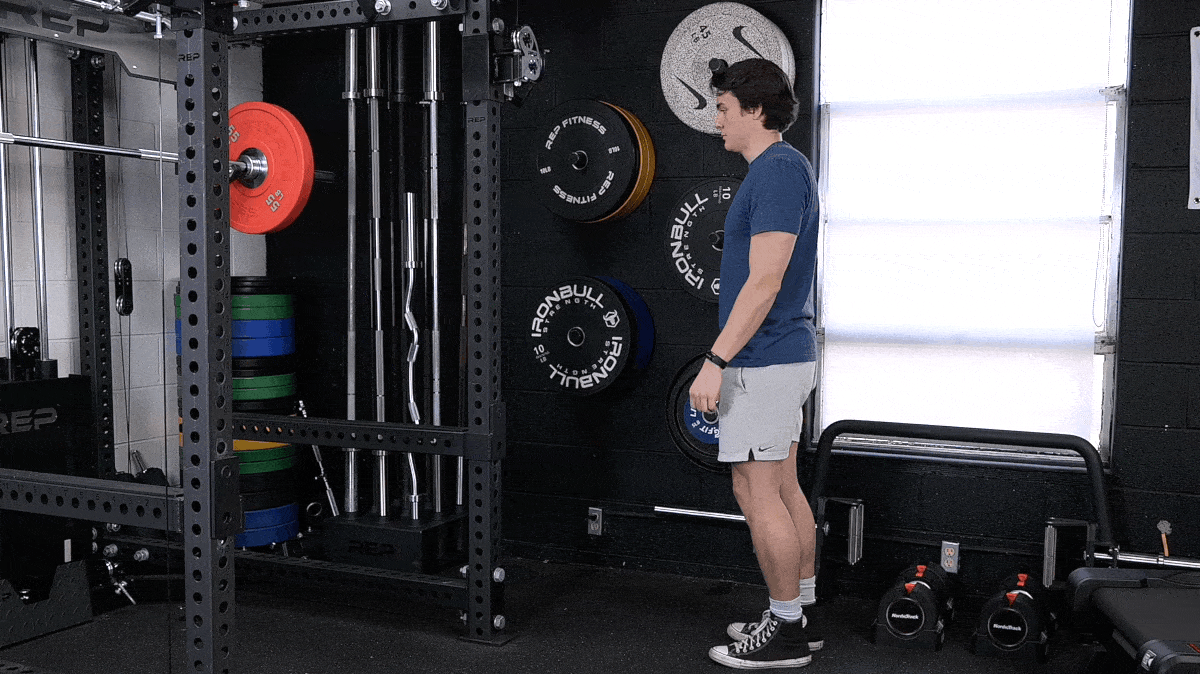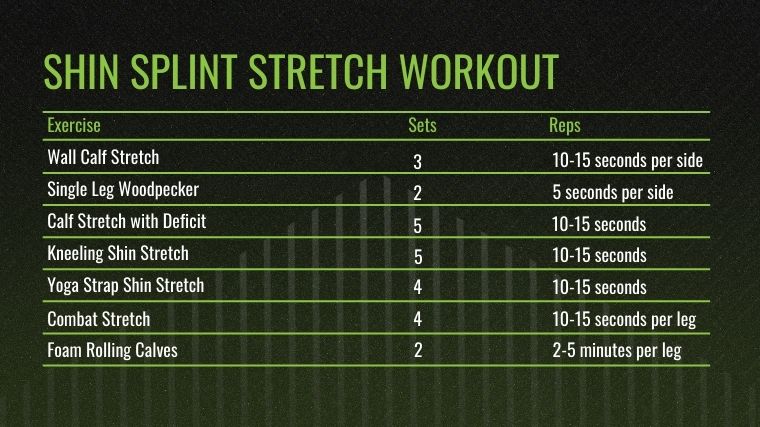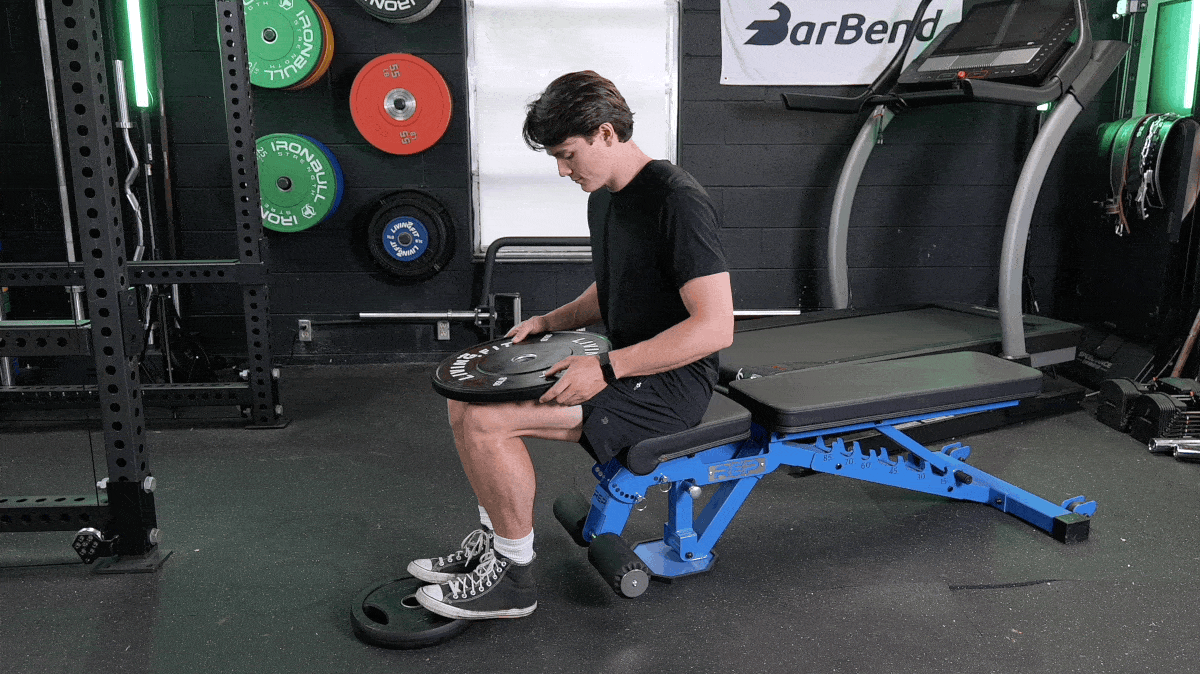[ad_1]
Have you ever felt a dull or stabbing pain in the front of your lower leg after running? (Or worse, in the middle of that 5K training?) Perhaps you’ve been running a particularly long run or maybe your run has taken you onto an unstable or hard surface like sand or gravel. Chances are—you may be experiencing spin splints.
Shin splints are a common condition among runners. A 2014 study found that among military recruits, runners, and dancers, between four to 35 percent experience shin splints, with distance runners being the largest group. (1)


So what causes shin splints and how do you get rid of them? Great questions! Keep reading to find out. You’ll learn how to do the best shin splint stretches and get insight into these aches and pains from Dr. Matt Szymanski, DPT, a performance physical therapist who specializes in treating athletes of all kinds.
Best Shin Splint Stretches
1. Wall Calf Stretch


| Equipment Needed | A wall or sturdy surface |
| Muscles Worked | Gastrocnemius, soleus |
| Sets & Reps | 3 x 10-15 seconds per side |
[Read More: Benefits of Standing Calf Raises]
The shin splint pain you’re experiencing may be caused by tightness in your calves, so stretching your calves out is a great way to alleviate your pain. (2) The parts of your lower legs work together so that if your calves are tight on the back of your leg, your shins in the front won’t be able to work optimally. This stretch targets your calves to help release the tightness in your shins.
How to Do It:
- Stand facing a wall with one foot forward and one foot back.
- Place your hands flat on the wall for support.
- Bend your front knee while keeping both feet flat on the ground.
- Keep the back leg straight and the heel on the ground.
- Lean into the wall until you feel a stretch in your calf muscle.
- Hold for 10-15 seconds per leg.
Modifications
- Make it Easier: Move your body closer to the wall to take some pressure off your calves.
- Make it Harder: Step further away from the wall with your back foot creating more distance between your feet. This will allow you to get a deeper stretch in your calves.
Coach’s Tip: Keep your arms engaged—but not locked out—and press your bodyweight into the wall to feel the full stretch in your calves.
2. Single-Leg Woodpecker
| Equipment Needed | None |
| Muscles Worked | Tibialis anterior, gastrocnemius, soleus, glutes, hamstrings |
| Sets & Reps | 2 x 5 per side, hold for 5-10 seconds |
This shin splint exercise strengthens your lower leg muscles and improves balance, which can help prevent shin splints by promoting proper alignment and stability. This is a great stretch for your shins and it also challenges ankle stability, which will help strengthen and support your lower body. This allows your lower body to function properly as a whole.
How to Do It:
- Stand up straight with your chest lifted, core engaged, and feet shoulder-width apart.
- Bring one leg up and balance on one foot while maintaining good posture.
- Lean forward on your grounded foot until the end point of control (before your heel starts to rise).
- Dig your toes and the heel of your grounded foot into the ground and hold for five to 10 seconds.
- Return your lifted foot down to the starting position with control.
- Repeat on the opposite leg.
Modifications
- Make it Easier: If you feel unstable, use a wall for support.
- Make it Harder: Add a rotation in the exercise by twisting at your hips, not your torso.
Coach’s Tip: Keep your body straight to get the most out of this exercise—hips neutral and knees straight. You should not hinge forward like in a deadlift.
3. Calf Stretch with Deficit
| Equipment Needed | A step or elevated surface; something sturdy to hold onto |
| Muscles Worked | Gastrocnemius, soleus, Achilles tendon |
| Sets & Reps | 5 x 10-15 seconds |
This is a great Achilles tendon and calf stretch. When your Achilles tendon is tight, its ability to absorb shock effectively may be limited, especially in high-impact exercises like running. Shock absorption is essential for safely managing the impact of your foot hitting the pavement with each stride. If your Achilles tendon is tight, your shins could overcompensate and take on additional stress.
How to Do It:
- Stand on a step or an elevated surface with the balls of your feet on the edge and your heels hanging off.
- Hold onto a sturdy surface like a column or railing.
- Allow your heels to sink below the level of the step to deepen the stretch in your calves.
- Hold for 10 to 15 seconds.
- Lift your heels back to neutral to relax before beginning the next rep.
Modifications
- Make it Easier: If you don’t have an elevated surface to set your heels on, you can perform this stretch on the ground by bringing one foot in front of the other and bending forward toward your front leg. Lift your toes to feel the stretch in your calves.
- Make it Harder: Perform this stretch with one leg at a time to get an isolated stretch on each side.
Coach’s Tip: Holding onto something allows you to focus on feeling the stretch in your calves and Achilles tendon without letting your balance get in the way.
4. Kneeling Shin Stretch
| Equipment Needed | None |
| Muscles Worked | Tibialis anterior |
| Sets & Reps | 5 x 10-15 seconds |
This stretch relieves tension in your tibialis anterior, which can help alleviate pain in your shins directly. However, you need good knee flexion to do it. If you find that sitting in this position hurts your knees, perform this stretch standing instead.
How to Do It:
- Kneel on the ground with your toes pointed behind you.
- Sit back on your heels and sit up straight with your core engaged.
- Hold for 10 to 15 seconds.
Modifications
- Make it Easier: Perform this stretch standing by bringing one foot back with your toes pointed behind you and resting the top side on the ground.
- Make it Harder: Put your body weight into your arms and the tops of your feet and press your knees and shins off the ground to get an extra stretch. Hold for 10 to 15 seconds before returning your shins and knees down to the floor.
Coach’s Tip: Pointing your toes to elongate them will ensure that you get the best stretch in your tibialis anterior, but be careful not to dig your toes into the ground.
5. Yoga Strap Shin Stretch
| Equipment Needed | Yoga strap or towel |
| Muscles Worked | Tibialis anterior, gastrocnemius, soleus |
| Sets & Reps | 4 sets for 10-15 seconds |
[Read More: The Best Leg Stretches to Bolster Your Lower Body Training]
Practicing this stretch helps with ankle mobility and helps alleviate tension in your calves and shins. Imbalances between the front and back of your leg can contribute to shin splints. Stretching your calves helps maintain muscle symmetry and reduces the risk of injury associated with shin splints.
How to Do It:
- Sit on the floor with your knees straight and legs extended in front of you.
- Loop a yoga strap (or towel) around the balls of your feet and hold the ends of the strap in your hands.
- Keep your knees straight and pull your arms into your sides until you feel a stretch in your lower leg muscles.
- Hold for 10 to 15 seconds.
Modifications
- Make it Easier: Instead of using a yoga strap, lean forward reaching toward your toes and point your toes toward your hands.
- Make it Harder: Lie on your back and lift one leg looped around the yoga strap in the air. Keep your knee straight as you pull the straps toward you the same way until you feel a stretch in your lower leg.
Coach’s Tip: Sit up tall with your spine neutral and core engaged to get the most out of the stretch.
6. Combat Stretch
| Equipment Needed | None |
| Muscles Worked | Tibialis anterior, gastrocnemius, soleus |
| Sets & Reps | 4x 10-15 seconds per leg |
[Read More: Try These Tight Calves Stretches to Improve Ankle Mobility]
This is a great stretch for your lower leg muscles and is particularly helpful for working on ankle mobility. Limited ankle mobility can exacerbate shin splints by altering your running mechanics, leading to increased stress on your shins. Working on ankle mobility helps you run with proper form and helps prevent further injury.
How to Do It:
- Kneel on one knee with your opposite foot on the ground next to your bent knee.
- Lean forward towards your knees while keeping your one foot flat on the ground.
- Keep leaning forward until you feel your heel is about to rise.
- Hold for 10 to 15 seconds.
- Switch legs and perform on the opposite side.
Modifications
- Make it Easier: Perform the stretch standing with your front leg on an elevated surface about two feet or so off the ground.
- Make it Harder: Lean further forward to increase the intensity of the stretch.
Coach’s Tip: Squeeze your toes and heel into the ground at the end range of motion to get the best stretch.
7. Foam Rolling Calves
| Equipment Needed | Foam roller |
| Muscles Worked | Gastrocnemius, soleus |
| Sets & Reps | 2-5 minutes per leg |
Myofascial release, or foam rolling, is not technically a stretch, but it helps relieve tension and tightness in your calf muscles and connective tissues in your lower leg. This promotes muscle relaxation and reduces discomfort associated with shin splints. Foam rolling your calves helps with mobility and reduces inflammation.
How to Do It:
- Sit on the floor with a foam roller under your calves.
- Place your hands on either side of your body a little wider than shoulder-width apart.
- Put your weight into the palms of your hands as you lift your butt off the ground.
- Roll up and down the length of your calves.
- Breathe through any resistance and focus on any area where you feel knots.
Modifications
- Make it Easier: Instead of pressing up through the ground and lifting your body, remain seated on the ground and rotate your legs left to right on the foam roller.
- Make it Harder: Use a lacrosse ball and focus on one leg at a time to isolate each calf.
Coach’s Tip: Placing your arms further than shoulder-width apart allows for greater stability and control.
Sample Shin Splint Stretch Workout
Stretching before and after your workout is essential in ensuring that your workout and recovery are effective. Properly warming up allows you to engage the muscles you will be using in your workout. This helps stave off potential injury and improves performance by allowing you to work out with excellent form.
The Warm-Up
Adding a balanced stretching routine into your fitness routine can be the key to unlocking your fitness goals. These stretches target the muscles in your lower legs and promote flexibility, strength, and stability. Incorporating these stretches into your routine can improve your overall performance, help reduce your risk of injury, and potentially alleviate shin splint pain.
To maximize the effectiveness of this warm-up, remember to perform each stretch with proper form and technique. Take your time with each exercise and focus on engaging and connecting to your muscles. This will make your warm-up more effective, allowing you to run injury-free.


[Read More: The Best Calf Exercises for Lower Body Support and Power]
- Wall Calf Stretch: 3 x 10-15 seconds per side
- Single Leg Woodpecker: 2 x 5 per side, hold for 5-10 seconds
- Calf Stretch with Deficit: 5 x 10-15 seconds
- Kneeling Shin Stretch: 5 x 10-15 seconds
- Yoga Strap Shin Stretch: 4 sets for 10-15 seconds
- Combat Stretch: 4x 10-15 seconds per leg
Foam Rolling Calves: 2-5 minutes per leg
Equipment Needed: A wall or sturdy surface, a step or elevated surface, a yoga strap or towel, and a foam roller.
Modifications
- Make it Easier: Pick only a few stretches to focus on so you can perfect each stretch individually.
- Make it Harder: Rather than holding each stretch, make the warm-up dynamic by moving through each stretch. More fluidly.
What Are Shin Splints?
Shin splints, medically known as medial tibial stress syndrome (MTSS), is a common exercise-related condition where you feel pain along the inner edge of your shinbone often caused by inflammation after performing repetitive high-impact activities like running or jumping.
Dr. Matt Szymanski, DPT, says it’s tricky to define what shin splints are because it’s an “umbrella term that refers to pain in the lower leg that is typically caused by high-impact sports or exercise.”
[Read More: Why Do My Shins Hurt When I Run?]
For runners, there are two main reasons you may experience the sensation of shin splints. The first is overtraining, especially when you suddenly increase the length or frequency of your runs without proper conditioning. If your muscles are not equipped to handle the increase in intensity, you may find yourself with shin splints.


[Read More: How Should the Shins Be Positioned In the Deadlift?]
The second is poor technique. According to Szymanski, “Running is a skill that needs to be developed just like a squat or a golf swing. It’s super easy to slip on a pair of shoes, head out the door, and pound the pavement for 30 to 60 minutes. But if you don’t know how to run well…that’s a recipe for pain.”
Stretching your lower legs may provide tremendous relief. If you’re experiencing shin splints, try some of these stretches to help ease your discomfort (and check in with a physical therapist).
Anatomy of the Shins
Here are the ins and outs of the fronts of your lower legs.
- Tibialis anterior: The tibialis anterior is the muscle at the front of your shin bone (tibia) and is responsible for dorsiflexion (raising your foot upwards toward your shin) and inversion (turning your foot towards the inside of your body to face your other foot). It also helps with balance and stability.
- Gastrocnemius: The gastrocnemius is the larger of the two calf muscles and it primarily flexes (extends) your foot at the ankle joint and assists in flexing your leg at the knee joint. Think of a ballerina on point– that’s flexion.
- Soleus: The soleus is found underneath your gastrocnemius and primarily flexes your foot.
Benefits of Stretching With Shin Splints
Taking the time to stretch your lower legs has been shown to help manage shin splints. (3) Stretching might not get to the root cause of your shin splints, but it can be a short-term shin splint treatment that can alleviate pain and help aid your recovery. Keep reading to find out how stretching with shin splints can benefit you.
It Can Improve Flexibility
Studies demonstrate that stretching can help improve flexibility. (4) This enhances your range of motion. The more flexibility in your calves, shins, and ankles, the more you can run on a variety of surfaces with ease and proper form.
It May Help Alleviate Pain
Shin splint pain often results from overuse or repetitive stress on your muscles and connective tissues in the lower leg.
[Read More: Tips for How to Prevent Shin Splints, Direct From a Physical Therapist]
Stretching helps relax these muscles, releasing tension and reducing soreness. Studies have shown that stretching for 10 minutes twice a day can reduce delayed onset muscle soreness and inflammation caused by tight muscles. (5)
It May Speed Up Recovery
Incorporating stretching into your rehabilitation program can speed up your recovery by reducing the tension and pain in your lower legs. Stretching also increases blood flow to the stretched area, which allows for better circulation. This can help accelerate your recovery time, allowing you to heal faster and get back to running quicker. (6)
Frequently Asked Questions
Can stretching get rid of shin splints?
Stretching can be highly beneficial in the short term for shin splints, but it does not get to the root cause of why you are experiencing them in the first place. If possible, Szymanski recommends that you modify the activity causing your shin splints for a while so that you can address the underlying issues and work to fully eliminate your shin splints. So, runners—this is a good time to take a break.
How do you get rid of shin splints?
Treating shin splints is more involved than simply stretching the pain away. First, make sure you have the right equipment. Switch out your running shoes every 300 to 500 miles or every six months. Orthopedic insoles or inserts are also an option if you have flat feet and your arch needs more support.
Cross-training will also help balance your routine, especially if your shin splints are caused by performing one exercise repeatedly, like running. Adding some variety to your workout can help relieve your overworked muscles. Sometimes shin splints are caused by weak muscles, so building muscle can alleviate your pain and support your legs by making them stronger.
If you’ve noticed that your shin splints are a recurring issue and not going away, seek out physical therapy or an expert in sports medicine to determine the root cause. They can help find a more permanent solution.
Is it OK to push through shin splints?
Because shin splints are a common overuse injury, you shouldn’t push through physical activity. Pushing through shin splints could cause further injury like a stress fracture. Instead, substitute the painful exercises with low-impact cardio like biking or swimming until the pain subsides, before slowly reintroducing it.
When should I see my healthcare provider?
Szymanski says, “If you have removed the offending activity and modified your training for four weeks and it comes right back after you start to add in running or your sport again, it’s time to see someone.” A physical therapist or qualified healthcare professional can help get to the source of your lower leg pain and help make adjustments to get rid of your shin splints for good.
Editor’s Note: The content on BarBend is meant to be informative in nature, but it should not be taken as medical advice. When starting a new training regimen and/or diet, it is always a good idea to consult with a trusted medical professional. We are not a medical resource. The opinions and articles on this site are not intended for use as diagnosis, prevention, and/or treatment of health problems. They are not substitutes for consulting a qualified medical professional.
References
- Reshef N, Guelich DR. Medial tibial stress syndrome. Clin Sports Med. 2012;31(2):273-290.
- Loudon JK, Dolphino MR. Use of foot orthoses and calf stretching for individuals with medial tibial stress syndrome. Foot Ankle Spec. 2010;3(1):15-20.
- Curr Rev Musculoskelet Med. 2009 Sep; 2(3): 127–133. Published online 2009 Oct 7.
- Krivickas LS. Anatomical factors associated with overuse sports injuries. Sports Med. 1997;24(2):132-146.
- Berrueta L, Muñoz-Vergara D, Martin D, et al. Effect of stretching on inflammation in a subcutaneous carrageenan mouse model analyzed at single-cell resolution. J Cell Physiol. 2023;238(12):2778-2793.
- Cureus. 2023 Jan; 15(1): e33905. Published online 2023 Jan 18.
[ad_2]
Source link
Fitnessnacks – #Shin #Splint #Stretches #Relieve #Running #Pain
Courtesy : https://barbend.com/shin-splint-stretches/
